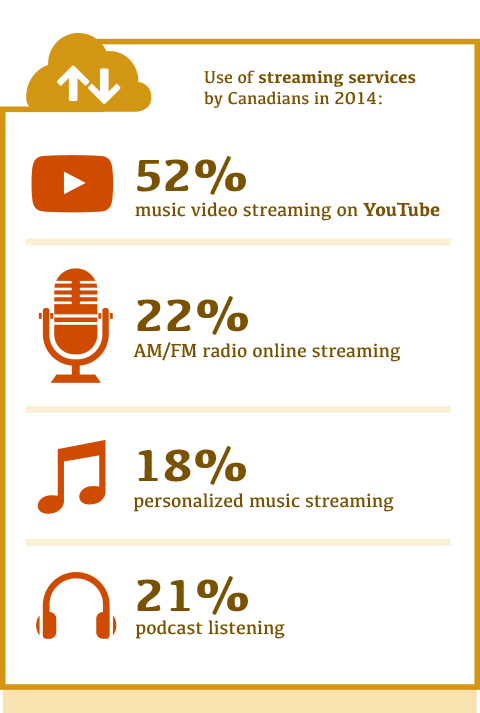 The Canadian Radio-television and Telecommunications Commission (CRTC) announced that it has released the final part of its 2015 Communications Monitoring Report.
The Canadian Radio-television and Telecommunications Commission (CRTC) announced that it has released the final part of its 2015 Communications Monitoring Report.
For more information visit: www.crtc.gc.ca
Unedited press release follows:
 Video content increasingly consumed on mobile technologies – CRTC releases report on the state of the Canadian broadcasting industry
Video content increasingly consumed on mobile technologies – CRTC releases report on the state of the Canadian broadcasting industry
OTTAWA, Oct. 29, 2015 – The Canadian Radio-television and Telecommunications Commission (CRTC) today released the final part of the 2015 Communications Monitoring Report, which provides information on the state of the broadcasting industry in Canada. The Communications Monitoring Report is now available in its entirety.
While the time spent watching conventional television declined slightly across all age groups in 2014, the overall average remained stable at 27.4 hours each week compared to 27.9 hours in 2013. Canadians aged 18 and over also watched 2.7 hours of television content over the Internet, an increase from 1.9 hours the previous year. Eight percent of Canadians report watching television exclusively online.
The percentage of Anglophones who watched Internet video content on a tablet grew from 20% in 2013 to 26% in 2014, while among Francophones it increased from 16% to 25% during the same period. The amount of Internet video content consumed on a smartphone grew from 23% in 2013 to 38% in 2014 for Anglophones, while it increased from 16% to 27% during the same period among Francophones.
The percentage of Canadian households subscribing to cable, satellite or Internet Protocol television (IPTV) services went from 83.7%, or 11.8 million households, in 2013 to 82%, or 11.6 million households, in 2014. IPTV, a relatively new means of receiving television services, grew more than four-fold to over 1.7 million subscribers in the last 5 years.
Canadians also had access to a variety of radio stations and audio services. In 2014, there was a small decline in the average time spent listening to radio stations across all age groups. As a result, Canadian listeners in markets measured by diaries consumed 18.8 hours of radio content per week in 2014, compared to 19.3 hours in 2013. Twenty-two percent of Canadians also streamed an AM or FM station’s signal online, and 18% used personalized online music streaming services.
In 2014, total broadcasting revenues increased 1.4% to reach $17.3 billion. The broadcasting sector invested nearly $3 billion in the creation of new television content made by Canadians, as well as nearly $60 million in new Canadian audio content and to support Canadian artists.
The 2015 Communications Monitoring Report provides a detailed overview of the Canadian communication industry, as well as industry data and information, including emerging trends and issues.
This year, the CRTC released the report in three parts. The first part deals with the state of the Canadian communication system and the second part focuses on the telecom sector. With today’s release of the third and final part, the full version of the report is now available.
Quick Facts
Choice of services
• In 2014, there were 663 authorized television services, including 392 Engligh-language services, 84 French-language services and 187 services in other languages.
• In 2014, there were 1,107 authorized radio services, including 846 English-language services, 222 French-language services and 39 services in other languages.
Television
• Average weekly viewing of traditional television remained consistent, coming in at 27.4 hours in 2014 compared to 27.9 hours in 2013.
• The adoption of television content over the Internet among Anglophones grew from 42% in 2013 to 47% in 2014, while among Francophones it increased from 39% to 42% during the same period. Nationally, 46% of adults watched Internet TV in 2014.
• Revenues for the television sector increased by 2%, going from $6.5 billion in 2013 to $6.6 billion in 2014.
Radio
• Revenues for the radio sector held steady at $1.61 billion in 2014, a 0.5% decrease from $1.62 billion in revenues in 2013.
• The percentage of Canadians that subscribe to satellite radio grew from 15% in 2013 to 16% in 2014.
• In 2014, 22% of Canadians streamed an AM or FM station’s signal over the Internet, compared with 20% the previous year.
• The percentage of Canadians who streamed a personalized Internet music service was unchanged at 18%.
Television service providers
• Sixty-three percent of television service subscribers had a cable subscription, 22% a satellite subscription and 15% had an IPTV subscription
• In 2014, Canadian households spent an average of $53.95 per month on television services provided by a cable, satellite or IPTV company.
• Revenues for television service providers increased by 1.4% from $8.9 billion in 2013 to $9 billion in 2014.
Quote
“Canadians have access to a wide array of choices, both traditional and online, for television and radio content. Content made by Canadians is available on all these platforms, and is well-supported by the broadcasting system. We encourage Canadians to use the information in the 2015 Communications Monitoring Report when they take part in public proceedings.”
Jean-Pierre Blais, Chairman of the CRTC
Related products
2015 Communications Monitoring Report
Infographic
Stay Connected
Follow us on Twitter @CRTCeng
Like us on Facebook www.facebook.com/crtceng
Ask a question or make a complaint